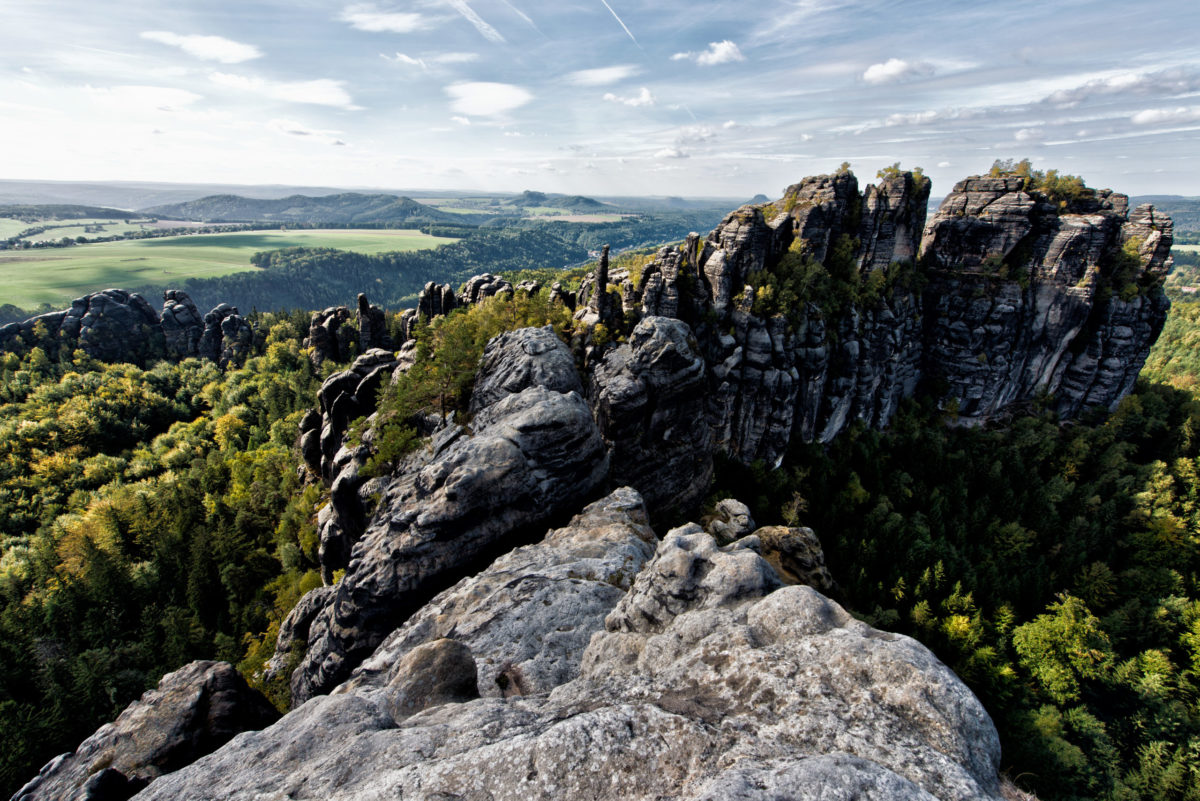The Elbe Sandstone Mountains
Primeval rock world and dreamlike cultural landscape
The Elbe Sandstone Mountains with their deep gorges and wide plains, table mountains and rock towers are full of variety and surprises. Every visit to the rugged landscape is an unforgettable experience of nature. Breathtaking views and fascinating buildings are just the beginning. Anyone who has walked through the soft sand and enjoyed the quiet corners will love the Elbe Sandstone Mountains.

The history of the Elbe Sandstone Mountains began more than 100 million years ago on the bottom of a Cretaceous sea. Today the dreamlike rock world is an ideal holiday destination, where culture and nature, activity and enjoyment can be combined in a relaxed way. There are countless excursion destinations and cultural assets to discover and after a hike, culinary delicacies of the region crown the day. The Elbe Sandstone Mountains – a place to enjoy!
The gates to Saxon Switzerland
The village Lohmen is called “Gateway to Saxon Switzerland” for good reason. From there you can quickly reach the Wesenitztal , which already gives a first-class foretaste of the Elbe Sandstone Mountains. The also nearby Uttewalder Grund is then pure romance and a recommended excursion destination, especially on hot days. A pleasant hiking trail runs deep down in the unspoilt gorge between the steep rock faces and leads through the Uttewalder Felsentor . The detour to the mysterious Teufelsgrund should not be missed. Now it is not far to the tranquil town of Wehlen , which stretches to the right and left of the Elbe. If you are in the mood for a bigger city, Pirna with its historic old town is exactly the right place. Even the painter Canaletto was enthusiastic about the flair and painted some of his famous works here.

The best prospects in the Bastei area and the Brand

This upstream part of the Elbe Sandstone Mountains is more developed and houses the most visited attraction in Saxon Switzerland, the Bastion with its famous stone bridge. In the midst of beautiful nature, the Hohnsteiner Six-valley-area and the Brand area with its Brandaussicht are particularly worthwhile destinations. A fantastic view of the great Elbe meander is offered after a short but steep ascent from the rock plateau of the Lilienstein (415 meters). This only table mountain on the right bank of the Elbe is surrounded on three sides by the Elbe – a magnificent natural spectacle! In addition to Town and Castle Hohnstein , culture lovers should also visit Castle Stolpen . Our tip: The Bastei and Brand area is a recommendation for photographers because of its quickly accessible viewpoints, especially for taking pictures of the famous Sea of Fog in spring and autumn.
Natural highlights in the Schrammsteine, Affensteine and Zschand
From the spa town of Bad Schandau you can get to the Schrammsteine in a very short time. High above the rugged cliffs, the Schrammstein view (417 meters) offers a tremendous panorama over the landscape. From there you can see not only the colossal Falkenstein (381 meters), which went down in the history of Elbe sandstone climbing as the first summit to be climbed. The view extends over the Elbe valley and the volcanic table mountains as far as Bohemian Switzerland. One can only guess at the deep cut of the Kirnitzsch mountain river.

The idyllic Kirnitzschtal is worth a trip and is ideal as a starting point for hikes in Upper Saxon Switzerland. A ride on the historic Kirnitzschtalbahn leads to the Lichtenhain waterfall . From there, the Kuhstall , an impressive rock gate and one of the oldest excursion destinations in the Elbe Sandstone Mountains, can be easily reached. A steep ascent through a narrow crevice, the so-called “ Himmelsleiter ” enables access to the upper view. Here you can see directly into the large rock groups of the Affensteine and the Zschand , where unforgettable hiking destinations such as the Little Winterberg (500 meters), the Frienstein with the Idagrotte or the Rear Robbery Castle (389 meters) are located.
The best in the Schmilka area and Bohemian Switzerland
The small village Schmilka on the Elbe is located near the Czech border. Anyone who visits the place will quickly realize that everything is organic here. The elegant Café Richter with its vegan cakes, the organic brewery and the lovingly restored Schmilksche Mühle, which is used again today for grinding and baking – in everything you can feel the glowing enthusiasm with which a sustainable organic refuge is being built here. From the end of the village, the flank of the Great Winterberg (554 meters) rises, which is also one of the oldest excursion destinations in Saxon Switzerland. A little below his summit, the hiker meets the branch to the Kipphorn view , the panorama of which already inspired the painter Caspar David Friedrich as a motif. The view extends into Bohemian Switzerland, which is not far away here.

Bohemian Switzerland has some superlatives to offer. From the border village Hřensko (Herrnskretschen) on the Elbe, the rock faces in the valley rise to the Elbe canyon , which is the deepest sandstone canyon in Europe at up to 300 meters. The Prebischtor can be reached on a hike through the wild Kamnitzklamm past Mezní Louka (Rainwiese) and via the Gabrielensteig become. With a span of more than 26 meters and a height of 16 meters, it is the largest sandstone rock bridge in Europe. Not far is the old glassblowing place Jetřichovice (Dittersbach) in the heart of the so-called “Dittersbacher Switzerland”, which because of its impressive excursion destinations such as Mariina skála (Marienfels) or the ruins of the medieval Felsenburg Falkenstein is very worth seeing. On the other side of the Elbe near the town of Děčín is the towering Hohe Schneeberg (772 meters). The highest mountain in the Elbe Sandstone Mountains sits enthroned in the midst of a unique low mountain range. The foothills of the rock massif lead to the Tyssaer Felsenstadt , a labyrinth of up to 30 meters high rock needles.
Treasures in the stone area and in the Bielatal
The area of the stones mainly includes the left Elbe landscape of the table mountains. The lonely Great Zschirnstein (562 meters) rises up tremendously next to the Zirkelstein (389 meters) and the Kaiserkrone (350 meters). The towering rock giants all show a breathtaking panorama from their plateaus. The rugged Pfaffenstein (434 meters) with its caves is famous for the “ Barbarine “. The slender rock needle is a symbol of Saxon Switzerland.

The nearby Königstein Fortress is no less well known. The large fortress area on the rocky plateau of the mountain is not only impressive as a structural ensemble. The walk on the 1,800-meter-long wall walk offers a unique 360-degree panoramic view of the Elbe sandstone landscape. The view extends to the Ore Mountains. The Bielatal lies like a small pearl in the Elbe sandstone. Countless rock pillars, up to 30 meters high, crowd together like a labyrinth. The rugged rocks that create the rock labyrinth Langenhennersdorf are only five to fifteen meters high. A marked path leads through the winding area of narrow rocky lanes, tunnels and small caves – the tour is great fun for young and old!


